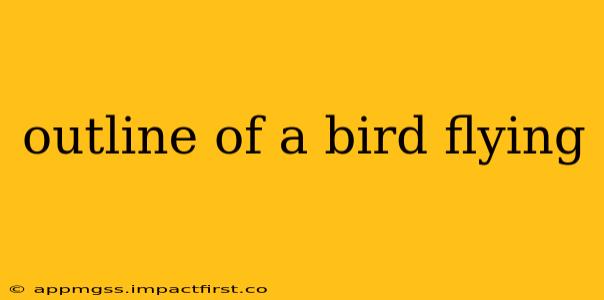The Anatomy of a Bird in Flight: An Outline of Avian Aerodynamics
This article will explore the intricate mechanics of bird flight, delving into the anatomical adaptations and aerodynamic principles that allow these creatures to conquer the skies. We'll go beyond a simple description, examining the complexities involved in achieving powered flight and the remarkable efficiency of avian locomotion.
I. Introduction: The Wonder of Avian Flight
- Briefly introduce the marvel of bird flight, highlighting its diversity and evolutionary significance.
- Touch upon the key anatomical features crucial for flight.
II. The Anatomy of a Flying Bird: A Detailed Look
- A. Wings: Detailed explanation of wing shape (airfoil), primary and secondary feathers, wingspan and its significance, alula (thumb wing) and its role in slow flight.
- 1. Feather Structure & Function: Microscopic view of feather barbs and barbules, explaining their role in creating a smooth, aerodynamic surface.
- 2. Wing Shape Variation: Discussing the different wing shapes (elliptical, high-aspect ratio, etc.) and how they correlate with flight style (e.g., soaring, maneuvering, rapid flapping).
- B. Muscles: Focusing on the powerful pectoral muscles (breast muscles) responsible for downstroke, and the supracoracoideus muscle for upstroke. Discussion of muscle mass and its relation to flight capabilities.
- C. Skeletal System: Lightweight yet strong bones (hollow, pneumatic bones), fused bones (furcula – wishbone, keel), and their contribution to efficient flight.
- D. Respiratory System: Unique avian respiratory system with air sacs, enabling efficient oxygen uptake crucial for sustained flight.
- E. Nervous System & Sensory Organs: Brain regions controlling flight, balance, and coordination. Role of vision and other senses (proprioception).
III. Aerodynamic Principles in Bird Flight
- A. Lift & Thrust: Explanation of Bernoulli's principle and how it generates lift. Description of thrust generation through wing flapping. The role of air pressure differences above and below the wing.
- B. Drag & Reducing Drag: Factors contributing to drag (friction, induced drag). Mechanisms birds use to reduce drag (streamlining, feather arrangement).
- C. Maneuverability: How birds change direction and control their flight path through wing adjustments, tail movements, and body posture.
IV. Different Flight Styles & Adaptations
- A. Soaring: Explanation of soaring techniques (thermal soaring, ridge soaring, dynamic soaring) and the adaptations birds use for efficient soaring.
- B. Flapping Flight: Description of different flapping styles and the adaptations necessary for different flight speeds and maneuvers.
- C. Hovering: Explanation of the unique challenges and adaptations involved in hovering. Examples of hovering birds (hummingbirds, kestrels).
V. The Evolution of Bird Flight
- Brief overview of the evolutionary history of bird flight, including theories on how birds evolved from non-flying ancestors (arboreal vs. cursorial theories).
VI. Conclusion: The Ongoing Mystery of Avian Flight
- Summarize the key aspects of bird flight and highlight areas of ongoing research and discovery.
- Encourage further exploration of this fascinating topic.
This outline provides a comprehensive structure for an in-depth exploration of bird flight. Each section can be expanded significantly with detailed explanations, examples, and scientific evidence. Remember to incorporate visuals (images and diagrams) to enhance understanding and engagement.
